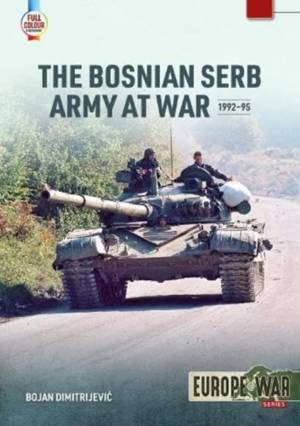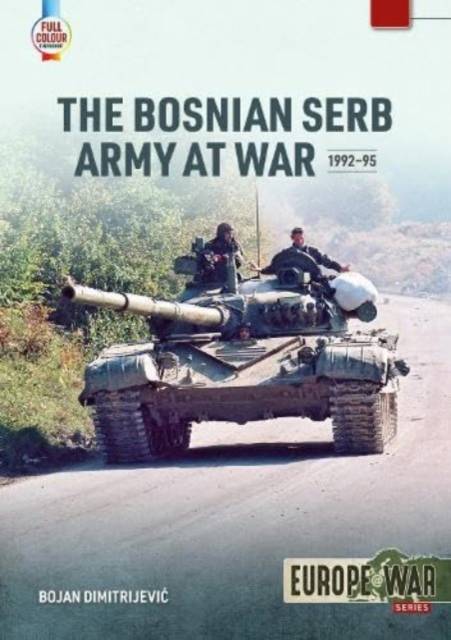
- Afhalen na 1 uur in een winkel met voorraad
- Gratis thuislevering in België vanaf € 30
- Ruim aanbod met 7 miljoen producten
- Afhalen na 1 uur in een winkel met voorraad
- Gratis thuislevering in België vanaf € 30
- Ruim aanbod met 7 miljoen producten
Zoeken
€ 27,95
+ 55 punten
Omschrijving
Comprehensive history of the Bosnian Serb Army 1992-95, detailing operations, organisation, personnel, and NATO involvement.
In the early 1990s, as the Cold War came to an end, the Federal Republic of Yugoslavia fragmented into separate entities seeking independence. What followed was a brutal civil war in which the Bosnian Serbs were particularly vilified by the world's media and political organisations. The Bosnian Serb Army at War 1992-95 seeks to move beyond many of the common narratives and examine the military history of this organisation.
This work provides a detailed account of the organisation, personnel, equipment and combat activities during the war years of 1992-95, including the establishment of the Vojske Republike Srpske largely from ethnic Serbs serving in the Yugoslav People's Army, organisational changes, and the difficulties surrounding the chain of command.
An examination of the initial operations and offensives in 1992-93 ('Koridor', Jajce, Podrinje, Trnovo) is followed by descriptions of the operations in 1994 (Gorazde, Bihac Pocket, wider Sarajevo) and 1995 (Sarajevo, Western Krajina, Srebrenica, Zepa, Drvar and Banja Luka) in which ultimately NATO and United Nations forces became embroiled, leading to Operation Deliberate Force, and the final Croat-Muslim offensive causing the end of the war under the auspices of the US shuttle diplomat Richard Holbrooke.
The final chapter examines the influence of the Dayton Accord, the Paris peace treaty, deployment of the NATO-led IFOR (Implementation Force) and demilitarising of the warring parties.
The Bosnian Serb Army at War 1992-95 brings a unique perspective on this army to Western readers, and includes many original photographs, and the @War series' signature colour artworks illustrating the men and equipment of the Bosnian Serb Army.
In the early 1990s, as the Cold War came to an end, the Federal Republic of Yugoslavia fragmented into separate entities seeking independence. What followed was a brutal civil war in which the Bosnian Serbs were particularly vilified by the world's media and political organisations. The Bosnian Serb Army at War 1992-95 seeks to move beyond many of the common narratives and examine the military history of this organisation.
This work provides a detailed account of the organisation, personnel, equipment and combat activities during the war years of 1992-95, including the establishment of the Vojske Republike Srpske largely from ethnic Serbs serving in the Yugoslav People's Army, organisational changes, and the difficulties surrounding the chain of command.
An examination of the initial operations and offensives in 1992-93 ('Koridor', Jajce, Podrinje, Trnovo) is followed by descriptions of the operations in 1994 (Gorazde, Bihac Pocket, wider Sarajevo) and 1995 (Sarajevo, Western Krajina, Srebrenica, Zepa, Drvar and Banja Luka) in which ultimately NATO and United Nations forces became embroiled, leading to Operation Deliberate Force, and the final Croat-Muslim offensive causing the end of the war under the auspices of the US shuttle diplomat Richard Holbrooke.
The final chapter examines the influence of the Dayton Accord, the Paris peace treaty, deployment of the NATO-led IFOR (Implementation Force) and demilitarising of the warring parties.
The Bosnian Serb Army at War 1992-95 brings a unique perspective on this army to Western readers, and includes many original photographs, and the @War series' signature colour artworks illustrating the men and equipment of the Bosnian Serb Army.
Specificaties
Betrokkenen
- Auteur(s):
- Uitgeverij:
Inhoud
- Aantal bladzijden:
- 98
- Taal:
- Engels
- Reeks:
Eigenschappen
- Productcode (EAN):
- 9781804513699
- Verschijningsdatum:
- 11/12/2025
- Uitvoering:
- Paperback
- Formaat:
- Trade paperback (VS)
- Afmetingen:
- 211 mm x 297 mm
- Gewicht:
- 392 g

Alleen bij Standaard Boekhandel
+ 55 punten op je klantenkaart van Standaard Boekhandel
Beoordelingen
We publiceren alleen reviews die voldoen aan de voorwaarden voor reviews. Bekijk onze voorwaarden voor reviews.








